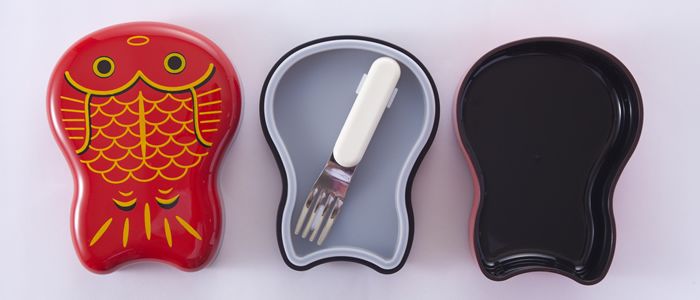
"Bentō": A Feast for the Eyes and Stomach
My “Bentō,” My Pride
Culture Lifestyle- English
- 日本語
- 简体字
- 繁體字
- Français
- Español
- العربية
- Русский
A good home-prepared bentō makes a great lunch: tasty even cold and never a bore. What is it about these boxed meals that makes them such good eats?
The five bloggers whose autumn bentō are featured below say they always make a point of giving their box lunches a seasonal feel and choosing the ingredients for a nutritionally balanced meal. It would seem that love is the best spice for a bentō.
(All photographs provided by the bloggers)
Creative Dishes with Seasonal Touches (Homemaker, female, forties)
Fall salmon bentō (for her husband, a company employee)
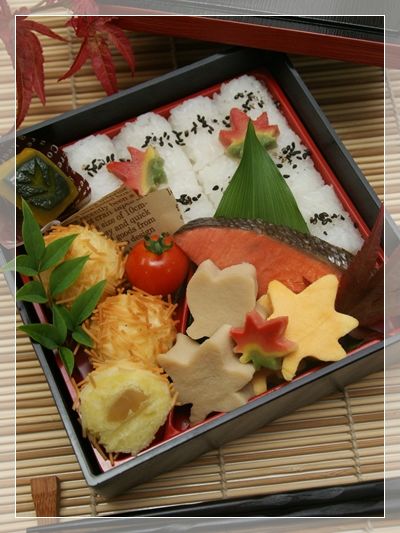 The sweet potato croquettes (lower left) are in the image of chestnuts in the burr, a fall food. I made them by wrapping candied chestnut in sweet potato dough and coating this with sōmen noodles before frying.
The sweet potato croquettes (lower left) are in the image of chestnuts in the burr, a fall food. I made them by wrapping candied chestnut in sweet potato dough and coating this with sōmen noodles before frying.
For the egg and simmered freeze-dried tofu (bottom center), I used a leaf-shaped cutter to make them look like autumn leaves. I also added namafu (wheat gluten) that has been colored and shaped like maple leaves.
I put plenty of vegetables in my husband’s bentō to keep down the calories.
Fall roasted rice-ball bentō (for her high school daughter)
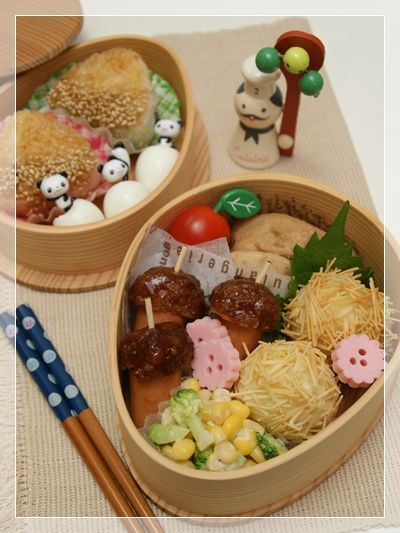 The sweet potato croquettes are the same as those for my husband. I made the roasted rice balls look like chestnuts by sprinkling white sesame seeds on them to finish, and the sausages and meatballs are supposed to be acorns.
The sweet potato croquettes are the same as those for my husband. I made the roasted rice balls look like chestnuts by sprinkling white sesame seeds on them to finish, and the sausages and meatballs are supposed to be acorns.
For my daughter’s bentō, I sometimes use bread or noodles instead of rice, include more high-calorie dishes, and make them into playful deko-ben (decorated bentō).
I try to give my bentō a seasonal feel, using whatever ingredients are in season at the time.
About 40 minutes a day, five days a week.
Blog: http://hotlunchtime.blog95.fc2.com/ (Japanese only)
A Relaxing Lunch Break at Work (Finance-industry worker, female, thirties)
Sweet potato side dish to go with rice (for self)
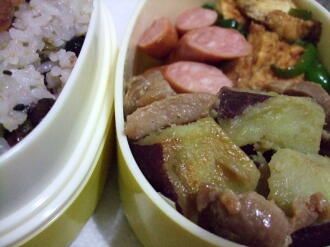 Sweet potato tends to be used for snacks, but it can be made into a savory dish that goes well with rice by simmering it in a soy-sauce-based broth.
Sweet potato tends to be used for snacks, but it can be made into a savory dish that goes well with rice by simmering it in a soy-sauce-based broth.
One of the advantages of making your own bentō is that you can take a good look at yourself: “I haven’t had enough vegetables lately, so I’ll use lots of vegetables for today’s lunch,” I might think, or, “I have some tough work to deal with today, so I’ll make myself a lunch full of my favorite dishes.”
As a rule, I choose vegetables and other foods with natural colors.
I basically avoid fancy seasonings. The only seasonings I usually use are miso, salt, soy sauce, sake, mirin (sweet sake), and ketchup. In my mind, seasonings that I grew up with are the easiest to use in my everyday cooking; they are also magical spices that let me relax during lunchtime at work.
About 30 minutes a day, five days a week. I take about two hours on the weekends to precook ingredients, which I then refrigerate or freeze. On weekdays I put several of them together in a bentō. I try to save cooking time on weekdays by preparing the meals without using knives and cutting boards.
My goal is to make bentō five days a week, Monday to Friday, but sometimes I am too tired and do not feel up to it. On days like that, I take it easy and allow myself to eat out.
I tell myself it is enough to make my own lunches about three times a week, since I would not be able to keep it up for very long if I were to get hung up on making bentō every single day. “Fun, effortless, and tasty” is my motto.
Blog: http://hina17.com/kokoro/ (Japanese only)
For My Child’s Growth (Homemaker, female, twenties)
Apple face bentō (for preschool-age son)
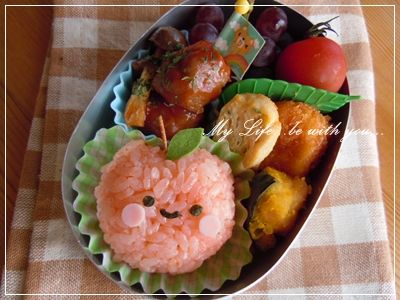 Apples, for which my home prefecture of Nagano is famous, come into season in the fall. So I made a rice ball in the shape of an apple.
Apples, for which my home prefecture of Nagano is famous, come into season in the fall. So I made a rice ball in the shape of an apple.
I also included mushrooms and grapes, both of which are fall foods. I make sure the food is in portions that are easy for a three-year-old to eat. The meatballs are tricky to eat with chopsticks, so I skewered them.
I try to make bentō that are fun to open and are nutritionally balanced.
About 30 minutes a day, five days a week
Blog: http://ameblo.jp/tajw8259/ (Japanese only)
A Taste You Can’t Get in the Store (Art director, male, thirties)
Home-cooked chikuzen-ni (simmered vegetables) with plenty of root vegetables (for self)
 Since I’d just come back from a trip overseas, I wanted to eat something with a deeply Japanese flavor, and this is what I came up with. The simmered dish had just the right rich flavors of bonito stock and shiitake mushrooms. Eating this really reminded me that I was back home.
Since I’d just come back from a trip overseas, I wanted to eat something with a deeply Japanese flavor, and this is what I came up with. The simmered dish had just the right rich flavors of bonito stock and shiitake mushrooms. Eating this really reminded me that I was back home.
When I shaped the rice balls, I used a cloth instead of plastic wrap. This absorbs excess moisture and makes the rice tasty and easier to eat.
It is important to me that I make my bentō every day. Preparing my own lunch makes it easier to manage my nutrition.
20–30 minutes a day, five days a week
Blog: http://maru-ben.com/ (Japanese only)
No-Hassle Cooking in the Morning (System engineer, male, thirties)
Sukiyaki bentō (for self)
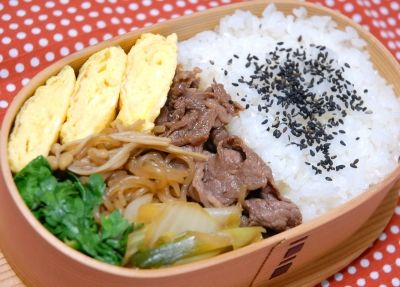 Since this is a bentō, which should never be soggy, I cooked the main entrée so as to boil away the vegetable juices.
Since this is a bentō, which should never be soggy, I cooked the main entrée so as to boil away the vegetable juices.
I avoid cooking ahead, and I try to make simple dishes that I can fix up in the 30 minutes it takes for the rice to cook.
I also make a point of using up each ingredient, such as by storing vegetable peels in plastic containers and sautéing them or pureeing them as seasoning for curry.
About 30 minutes a day, three times a week on average
Blog: http://bokuben.jugem.jp/ (Japanese only)
(Originally written in Japanese.)


